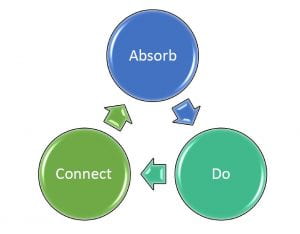Three types of learning activities
As you align course activities with learning outcomes by using Bloom’s taxonomy, you may find it helpful to array them using an “absorb, do, connect” structure. This structure breaks activities down into three types:
Absorb
Absorb activities are those in which learners read, listen, and watch, and are used to inform and inspire. Examples may include readings, presentations, listening to audio, watching videos, or virtual field trips which help students obtain new information and gain knowledge.
Do
These are activities in which students “do something” to learn. Examples of these are activities in which learners actively practice, explore, interview, discover, or take part in simulations or games.
Connect
These activities help students “apply” what they are learning with what they already know. Examples could include questioning activities, stories told by learners, job aids, research, or authentic work samples. The connect activities are an application of new knowledge to past experience and serve as a bridge for learning.
Arraying Activities in a Sequence

Not every lesson will have a connect activity, but in general, it is good to plan activities so that students acquire information (absorb) and then practice information (do) and apply information (connect). A common example is for students to read a textbook (absorb) and discuss their knowledge in a Canvas discussion (do) in preparation for an exam (connect).
Sometimes these activities overlap. For example, embedding questions in a video is one way to have students practice their knowledge while they absorb it.
On other occasions, students may practice their knowledge ahead of absorbing it. For example, a pre-reading quiz or scavenger hunt can point students to important information in a complicated text. This way the instructor can help students filter out the information that they should spend their time absorbing.
Connect activities often come at the end of an absorb/do sequence as students are often practicing for activities such as group projects, speeches, exams, etc. Yet, there are other activities that students connect to course material. The student survey mentioned in the welcoming module, for example, may ask students about their motivations for taking the class. This can be a subtle way to orient the student learning toward their lived experience. Similarly, reflective exercises can be done prior to a new unit of instruction or as a way to bridge two modules together. In this way, connect activities can be the glue that holds modules together while also forging bonds between the students and the course material.
The sequence of absorb, do, and connect activities is often linear, but it does not have to be. Whatever order you go in, it is important to ask: how will students acquire knowledge (absorb)? How will they practice (do)? And, how will they apply their knowledge (connect)? Finding activities that lead students through all three phases will help answer the question: what do we do in an online class?